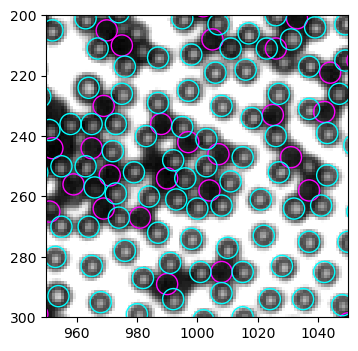Improve the accuracy and efficiency of the tracking
Contents
Improve the accuracy and efficiency of the tracking#
There are two major issues that limits the use of the current tracking code:
Accuracy: the separation between black and white is not satisfactory; when finding white particles, many false positives are detected.
Efficiency: on a larger image, the code runs very slowly (e.g. it took me 3 min for a 2048x555 image)
In this notebook, we try to improve the performance of the tracking code in these two aspects.
[3]:
from skimage import io, measure, draw
import matplotlib.pyplot as plt
from bwtrack import *
from matplotlib.patches import Circle
from matplotlib.collections import PatchCollection
import time
from myimagelib.myImageLib import bestcolor
[4]:
img = io.imread("https://github.com/ZLoverty/bwtrack/raw/main/test_images/large.tif")
plt.imshow(img, cmap="gray")
[4]:
<matplotlib.image.AxesImage at 0x2694778c640>

0 Run original code#
So we can compare with, and see if it is improved or not.
0.1 Find bw on the large image#
[3]:
%%time
black = find_black(img, size=7)
black = min_dist_criterion(black, 7)
white = find_white(img, size=7)
C:\Users\liuzy\Documents\Github\mylib\xcorr_funcs.py:42: RuntimeWarning: divide by zero encountered in divide
out = out / np.sqrt(image * template)
C:\Users\liuzy\Documents\Github\mylib\xcorr_funcs.py:42: RuntimeWarning: divide by zero encountered in divide
out = out / np.sqrt(image * template)
C:\Users\liuzy\Documents\Github\mylib\xcorr_funcs.py:42: RuntimeWarning: invalid value encountered in divide
out = out / np.sqrt(image * template)
CPU times: total: 3min 5s
Wall time: 3min 9s
It would be nice to avoid this warning of “divided by zero”.
0.2 Plot particle locations#
[9]:
%%time
fig, ax = plt.subplots(dpi=400)
ax.imshow(img, cmap="gray")
for num, i in black.iterrows():
circ = Circle((i.x, i.y), radius=3.5, ec="yellow", fill=False, lw=0.5)
ax.add_patch(circ)
for num, i in white.iterrows():
circ = Circle((i.x, i.y), radius=3.5, ec="cyan", fill=False, lw=0.5)
ax.add_patch(circ)
ax.axis("off")
CPU times: total: 37 s
Wall time: 37.3 s
[9]:
(-0.5, 2047.5, 554.5, -0.5)

A faster way to plot many circles using PatchCollection. See ref.
[221]:
%%time
b_circ = [plt.Circle((xi, yi), radius=3.5, linewidth=.1, fill=False, ec="magenta") for xi, yi in zip(black.x, black.y)]
b = PatchCollection(b_circ, match_original=True)
w_circ = [plt.Circle((xi, yi), radius=3.5, linewidth=.1, fill=False, ec="cyan") for xi, yi in zip(white.x, white.y)]
w = PatchCollection(w_circ, match_original=True)
fig, ax = plt.subplots(dpi=400)
ax.imshow(img, cmap="gray")
ax.add_collection(b)
ax.add_collection(w)
CPU times: total: 1.28 s
Wall time: 1.28 s
[221]:
<matplotlib.collections.PatchCollection at 0x24782002430>

The Circle patch plot takes 37 s, while PatchCollection plot takes 1.28 ms. Plotting efficiency is improved a lot.
[91]:
# save results
p = [black.assign(bw="black"), white.assign(bw="white")]
particles = pd.concat(p)
particles.to_csv("results_v0.csv", index=False)
0.3 Take a small area for this test#
In the whole image, it is not easy to see clearly which detections are problematic. After careful inspection, I find the right side (x>1800) to have bad detection quality. So we crop a 100x100 window in the upper right corner and test new code here.
[223]:
b_circ = [plt.Circle((xi, yi), radius=3.5, linewidth=1, fill=False, ec="magenta") for xi, yi in zip(black.x, black.y)]
b = PatchCollection(b_circ, match_original=True)
w_circ = [plt.Circle((xi, yi), radius=3.5, linewidth=1, fill=False, ec="cyan") for xi, yi in zip(white.x, white.y)]
w = PatchCollection(w_circ, match_original=True)
fig, ax = plt.subplots(dpi=100)
left, right, bottom, top = 1948, 2048, 100, 0
ax.imshow(img[top:bottom, left:right], cmap="gray", extent=(left, right, bottom, top))
ax.add_collection(b)
ax.add_collection(w)
[223]:
<matplotlib.collections.PatchCollection at 0x24781d79eb0>
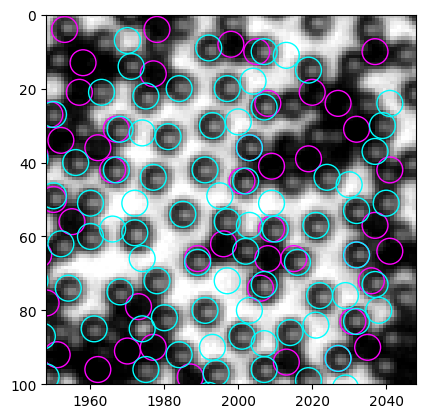
We see the problems clearly in this cropped image. - Some particles are identified as both black and white - some empty regions are identified as white particles
1 Improve accuracy#
1.1 Misclassification of black and white#
1.1.1 What’s wrong with mean intensity?#
White particles are sometimes recognized as black in the example above. This is likely due to the inproper thres value. Indeed, although we determined thres=3500 by looking at the “mass” (intensity sum) histogram for the first example, this histogram is not part of the routine. As a result, when dealing with other images, where imaging conditions and preproccessings are modified, the old method fails.
Let’s first check what goes wrong with mean intensity.
[227]:
mask_b = np.zeros(img.shape)
for num, i in black.iterrows():
rr, cc = draw.disk((i.y, i.x), 3)
mask_b[rr, cc] = 1
[228]:
plt.imshow(mask_b[0:200, 0:250], cmap="gray")
[228]:
<matplotlib.image.AxesImage at 0x24792ec3c40>
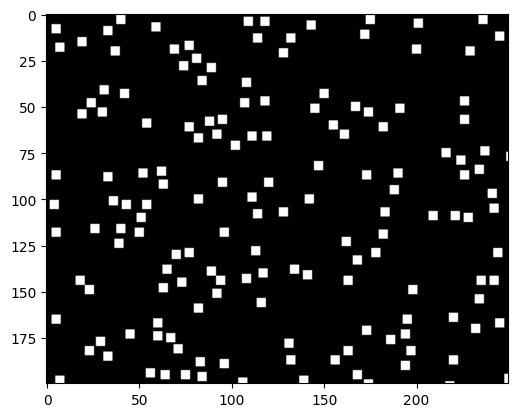
Now, in mask_b, all the detected black particles are marked as white disks. This is a mask that allows us to label and the regions where we detect black particles using skiamge.measure.
[229]:
label_img = measure.label(mask_b)
regions = measure.regionprops_table(label_img, intensity_image=img, properties=("label", "centroid", "intensity_mean")) # use raw image for computing properties
regions is a dict object, containing the properties of all the regions listed in the arrays. For example, here we ask measure.regionprops_table() to return labels, positions and mean intensity of all the regions by passing properties=("label", "centroid", "intensity_mean") to the method, and we get a dict of {label, centroid-0, centroid-1, intensity_mean}.
This dict can be passed directly to pd.DataFrame() to construct a table.
[238]:
table = pd.DataFrame(regions)
table.head()
[238]:
| label | centroid-0 | centroid-1 | intensity_mean | |
|---|---|---|---|---|
| 0 | 1 | 3.0 | 40.0 | 21.12 |
| 1 | 2 | 3.0 | 175.0 | 76.48 |
| 2 | 3 | 3.0 | 236.0 | 21.76 |
| 3 | 4 | 3.0 | 374.0 | 53.44 |
| 4 | 5 | 3.0 | 381.0 | 17.12 |
Now, we can visualize the mean intensity histogram.
[231]:
table["intensity_mean"].hist(bins=30)
[231]:
<AxesSubplot: >
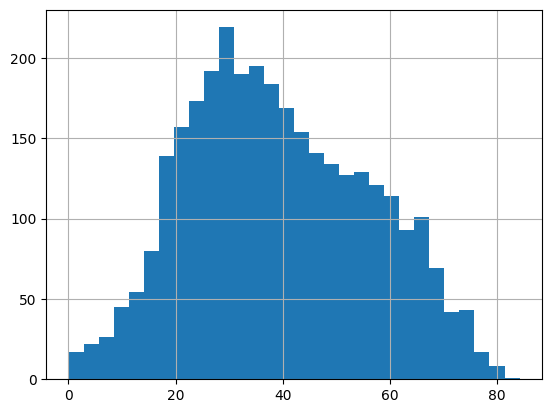
Unfortunately, we don’t observe clear separation between dark and bright features (for the whole image). Actually, we can still see clear difference in mean intensity between black and white particles in a local region. For example, below we plot all detected black particles in the 100x100 corner.
[242]:
b_circ = [plt.Circle((xi, yi), radius=3.5, linewidth=1, fill=False, ec="magenta") for xi, yi in zip(black.x, black.y)]
b = PatchCollection(b_circ, match_original=True)
fig, ax = plt.subplots(dpi=100)
left, right, bottom, top = 1948, 2048, 100, 0
ax.imshow(img[top:bottom, left:right], cmap="gray", extent=(left, right, bottom, top))
ax.add_collection(b)
for num, i in table.iterrows():
ax.annotate(int(i.label), (i["centroid-1"], i["centroid-0"]), xycoords="data", color="yellow")
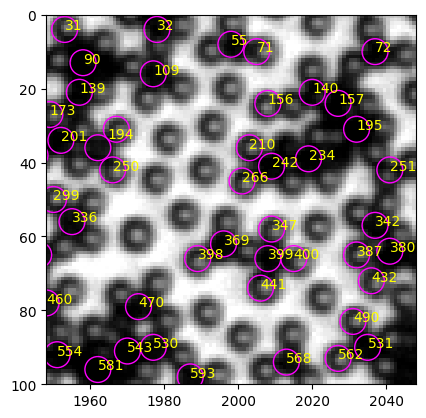
In the region shown above, particle#242 is a typical black, and particle#210 is a typical white. They are close to each other, so the local light condition should be similar. Let’s look at their mean intensity.
[239]:
table.query("label in [242, 210]")
[239]:
| label | centroid-0 | centroid-1 | intensity_mean | |
|---|---|---|---|---|
| 209 | 210 | 36.0 | 2003.0 | 58.20 |
| 241 | 242 | 41.0 | 2009.0 | 2.04 |
The black particle mean intensity is just 2.04, while the white mean intensity is 58.20 ! Does this mean we can set the mean intensity threshold to be very small, like 5? We need to check a black particle in a region where light is stronger, e.g. the center of the image. Let’s look at a crop (1000, 1100, 300, 200).
[244]:
b_circ = [plt.Circle((xi, yi), radius=3.5, linewidth=1, fill=False, ec="magenta") for xi, yi in zip(black.x, black.y)]
b = PatchCollection(b_circ, match_original=True)
left, right, bottom, top = 1000, 1100, 300, 200
fig, ax = plt.subplots(dpi=100)
ax.imshow(img[top:bottom, left:right], cmap="gray", extent=(left, right, bottom, top))
ax.add_collection(b)
for num, i in table.iterrows():
ax.annotate(int(i.label), (i["centroid-1"], i["centroid-0"]), xycoords="data", color="yellow")
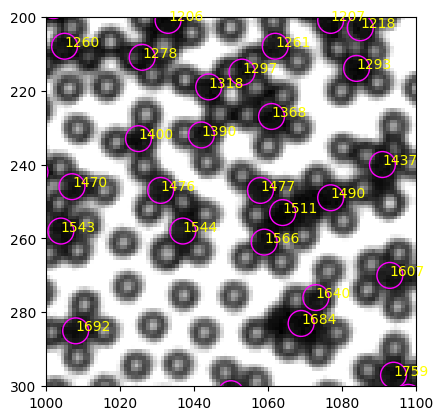
A typical black particle#1566
[245]:
table.query("label in [1566]")
[245]:
| label | centroid-0 | centroid-1 | intensity_mean | |
|---|---|---|---|---|
| 1565 | 1566 | 261.0 | 1059.0 | 43.16 |
The mean intensity is 43.16, much larger than the black in the corner (2.04). It is also close to a white particle mean intensity in the corner. The illumination inhomogeneity is exactly the reason why we no longer see the separation in the mean intensity (or total mass to be more exact) like in smaller images. And that leads to the misclassification of black and white in the original method.
1.1.2 Seek better criteria#
Mean intensity fails, so what can we do? Natural answer is let’s look at other properties of black and white particles and see if there are criteria better than mean intensity.
Standard deviation#
I realize that most white particles have large intensity gradient compared to black particles. As a result, if I compute the standard deviation \(\sigma\) of pixel intensities in a particle, we should have
[249]:
label_img = measure.label(mask_b)
regions = measure.regionprops_table(label_img, intensity_image=img, properties=("label", "centroid", "image_intensity")) # use raw image for computing properties
[250]:
table = pd.DataFrame(regions)
table.head()
[250]:
| label | centroid-0 | centroid-1 | image_intensity | |
|---|---|---|---|---|
| 0 | 1 | 3.0 | 40.0 | [[7, 5, 11, 14, 17], [11, 13, 16, 23, 16], [13... |
| 1 | 2 | 3.0 | 175.0 | [[51, 43, 33, 23, 33], [68, 70, 65, 61, 55], [... |
| 2 | 3 | 3.0 | 236.0 | [[10, 10, 8, 8, 17], [14, 16, 13, 8, 33], [16,... |
| 3 | 4 | 3.0 | 374.0 | [[46, 33, 20, 7, 8], [80, 59, 38, 21, 13], [11... |
| 4 | 5 | 3.0 | 381.0 | [[4, 2, 7, 16, 19], [10, 5, 8, 20, 19], [8, 8,... |
The image_intensity column has the pixel information inside each particle feature. An example of particle#1 is shown below.
[253]:
plt.imshow(table.loc[0, "image_intensity"])
[253]:
<matplotlib.image.AxesImage at 0x247a0228160>
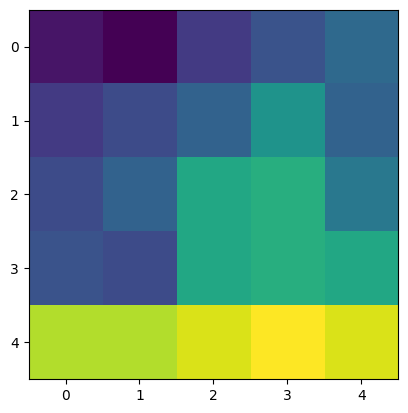
Let’s compute the pixel standard deviations of all the features.
[254]:
table["stdev"] = table["image_intensity"].map(np.std)
Then, let’s review the selected particles again:
[256]:
table.query("label in [242, 210, 1566]")
[256]:
| label | centroid-0 | centroid-1 | image_intensity | stdev | |
|---|---|---|---|---|---|
| 209 | 210 | 36.0 | 2003.0 | [[32, 33, 46, 42, 55], [46, 77, 102, 81, 67], ... | 29.223278 |
| 241 | 242 | 41.0 | 2009.0 | [[0, 0, 0, 0, 1], [1, 0, 0, 0, 0], [0, 0, 0, 0... | 2.778201 |
| 1565 | 1566 | 261.0 | 1059.0 | [[52, 38, 43, 43, 33], [52, 42, 42, 39, 33], [... | 4.838843 |
Particle#1566 shows small standard deviation, a good sign. Let’s look at the distribution of standard deviation throughout the whole image.
[258]:
table["stdev"].hist(bins=20)
[258]:
<AxesSubplot: >
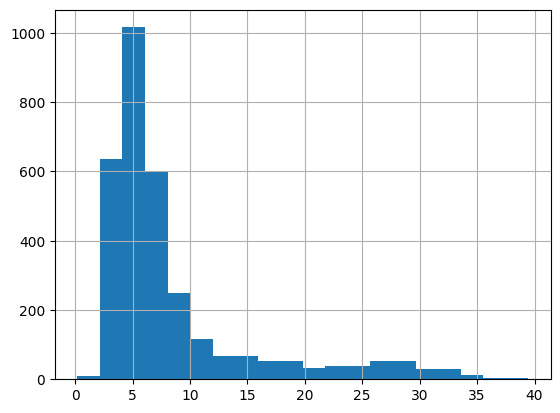
I still don’t see two peaks. This might be because I only look at the detected black particles, so not many white particles are in this data set!
If I include the white particles too:
[261]:
mask_bw = np.zeros(img.shape)
for num, i in pd.concat([black, white]).iterrows():
rr, cc = draw.disk((i.y, i.x), 3)
mask_bw[rr, cc] = 1
[263]:
plt.imshow(mask_bw)
[263]:
<matplotlib.image.AxesImage at 0x247a02fc4c0>

The above is a mask for both black and white particles. Since we did not check distance between black and white, there might be problems. For example, when particles overlap, larger connected regions can appear, and we lose some particles due to this. We can apply distance check in the whole tracking result to avoid this problem.
[264]:
fig, ax = plt.subplots(dpi=100)
left, right, bottom, top = 1948, 2048, 100, 0
ax.imshow(mask_bw[top:bottom, left:right], cmap="gray", extent=(left, right, bottom, top))
[264]:
<matplotlib.image.AxesImage at 0x247a034fb20>
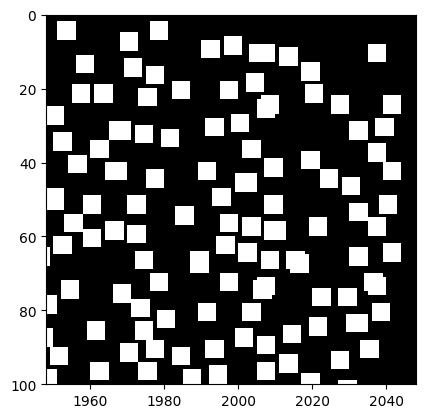
[265]:
label_img = measure.label(mask_bw)
regions = measure.regionprops_table(label_img, intensity_image=img, properties=("label", "centroid", "image_intensity")) # use raw image for computing properties
table = pd.DataFrame(regions)
table.head()
[265]:
| label | centroid-0 | centroid-1 | image_intensity | |
|---|---|---|---|---|
| 0 | 1 | 5.000000 | 39.500000 | [[0, 7, 5, 11, 14, 17], [0, 11, 13, 16, 23, 16... |
| 1 | 2 | 3.000000 | 175.000000 | [[51, 43, 33, 23, 33], [68, 70, 65, 61, 55], [... |
| 2 | 3 | 7.364865 | 240.364865 | [[10, 10, 8, 8, 17, 0, 0, 0, 0, 0, 0, 0, 0, 0]... |
| 3 | 4 | 3.000000 | 374.000000 | [[46, 33, 20, 7, 8], [80, 59, 38, 21, 13], [11... |
| 4 | 5 | 5.250000 | 386.250000 | [[4, 2, 7, 16, 19, 0, 0, 0, 0, 0, 0, 0, 0, 0, ... |
[266]:
table["stdev"] = table["image_intensity"].map(np.std)
[268]:
table["stdev"].hist(bins=30)
[268]:
<AxesSubplot: >
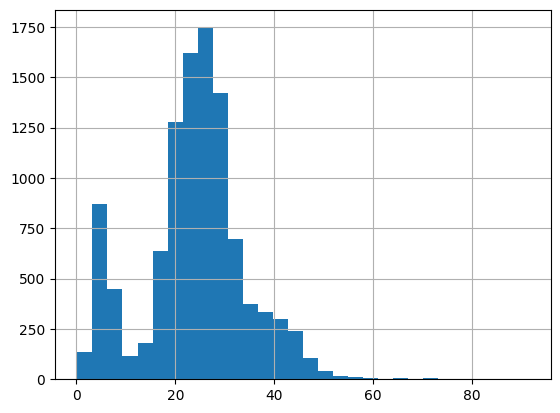
Beautiful two-peak histogram! The threshold value is roughly 15. We now go back to the old data black and white to implement the threshold and check the results
[269]:
mask_b = np.zeros(img.shape)
for num, i in black.iterrows():
rr, cc = draw.disk((i.y, i.x), 3)
mask_b[rr, cc] = 1
[270]:
label_img = measure.label(mask_b)
regions = measure.regionprops_table(label_img, intensity_image=img, properties=("label", "centroid", "image_intensity")) # use raw image for computing properties
table = pd.DataFrame(regions)
table.head()
[270]:
| label | centroid-0 | centroid-1 | image_intensity | |
|---|---|---|---|---|
| 0 | 1 | 3.0 | 40.0 | [[7, 5, 11, 14, 17], [11, 13, 16, 23, 16], [13... |
| 1 | 2 | 3.0 | 175.0 | [[51, 43, 33, 23, 33], [68, 70, 65, 61, 55], [... |
| 2 | 3 | 3.0 | 236.0 | [[10, 10, 8, 8, 17], [14, 16, 13, 8, 33], [16,... |
| 3 | 4 | 3.0 | 374.0 | [[46, 33, 20, 7, 8], [80, 59, 38, 21, 13], [11... |
| 4 | 5 | 3.0 | 381.0 | [[4, 2, 7, 16, 19], [10, 5, 8, 20, 19], [8, 8,... |
[276]:
table["stdev"] = table["image_intensity"].map(np.std)
black_valid = table.query("stdev < 15")
[277]:
b_circ = [plt.Circle((xi, yi), radius=3.5, linewidth=1, fill=False, ec="magenta") for xi, yi in zip(table["centroid-1"], table["centroid-0"])]
b = PatchCollection(b_circ, match_original=True)
left, right, bottom, top = 1948, 2048, 100, 0
fig, ax = plt.subplots(ncols=2, dpi=200)
ax[0].imshow(img[top:bottom, left:right], cmap="gray", extent=(left, right, bottom, top))
ax[0].add_collection(b)
for num, i in table.iterrows():
ax[0].annotate(int(i.label), (i["centroid-1"], i["centroid-0"]), xycoords="data", color="yellow")
b_circ = [plt.Circle((xi, yi), radius=3.5, linewidth=1, fill=False, ec="magenta") for xi, yi in zip(black_valid["centroid-1"], black_valid["centroid-0"])]
b = PatchCollection(b_circ, match_original=True)
ax[1].imshow(img[top:bottom, left:right], cmap="gray", extent=(left, right, bottom, top))
ax[1].add_collection(b)
for num, i in black_valid.iterrows():
ax[1].annotate(int(i.label), (i["centroid-1"], i["centroid-0"]), xycoords="data", color="yellow")
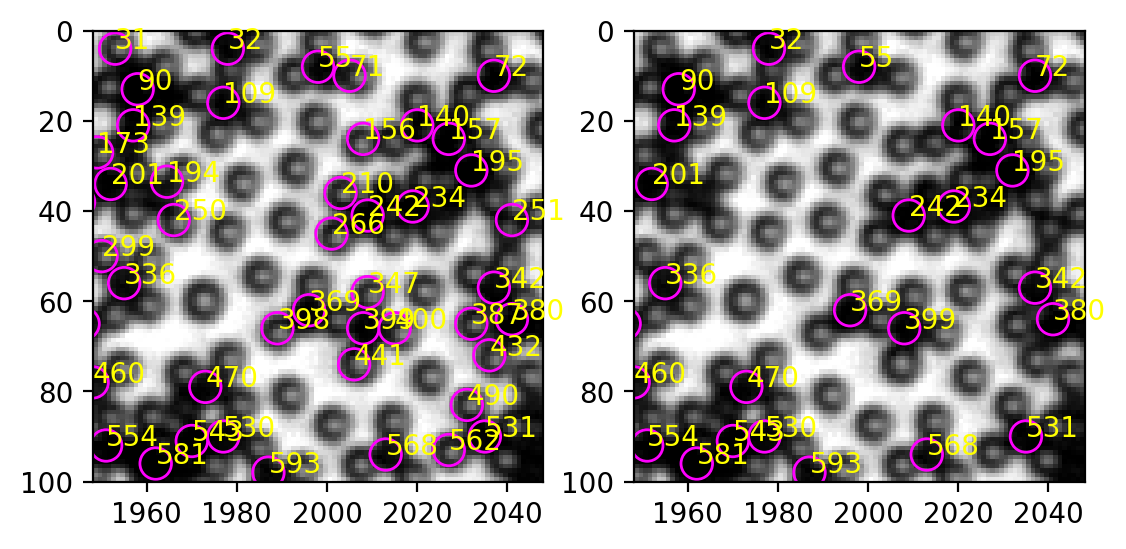
In the upper right corner, most white particles are excluded, while all the black particles are retained.
Other criteria#
Since standard deviation works, we currently don’t need more. I put a section here to hold the place for future development.
1.2 White false positive#
Apart from misclassifying white particles as black, the old method also finds many false positives, particularly when looking for white particles. See example below.
[278]:
w_circ = [plt.Circle((xi, yi), radius=3.5, linewidth=1, fill=False, ec="cyan") for xi, yi in zip(white.x, white.y)]
w = PatchCollection(w_circ, match_original=True)
fig, ax = plt.subplots(dpi=100)
left, right, bottom, top = 1948, 2048, 100, 0
ax.imshow(img[top:bottom, left:right], cmap="gray", extent=(left, right, bottom, top))
ax.add_collection(w)
[278]:
<matplotlib.collections.PatchCollection at 0x247a5ed8310>
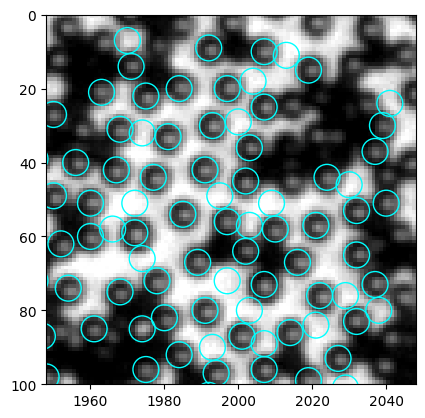
In this specific region, the false positives are much brighter than the actual particles. However, the light inhomogeneity issue might again hinder the possibility of using mean intensity as the criterion. Let’s take a look.
1.2.1 Mean intensity#
[280]:
mask_w = np.zeros(img.shape)
for num, i in white.iterrows():
rr, cc = draw.disk((i.y, i.x), 3)
mask_w[rr, cc] = 1
[282]:
label_img = measure.label(mask_w)
regions = measure.regionprops_table(label_img, intensity_image=img, properties=("label", "centroid", "intensity_mean", "image_intensity")) # use raw image for computing properties
table = pd.DataFrame(regions)
table.head()
[282]:
| label | centroid-0 | centroid-1 | intensity_mean | image_intensity | |
|---|---|---|---|---|---|
| 0 | 1 | 5.0 | 149.0 | 62.80 | [[38, 51, 57, 55, 54], [46, 90, 106, 87, 57], ... |
| 1 | 2 | 5.0 | 168.0 | 220.40 | [[255, 253, 236, 206, 184], [255, 255, 250, 23... |
| 2 | 3 | 5.0 | 193.0 | 103.00 | [[78, 78, 93, 83, 58], [71, 96, 128, 134, 86],... |
| 3 | 4 | 5.0 | 362.0 | 108.76 | [[115, 99, 98, 98, 103], [102, 122, 125, 100, ... |
| 4 | 5 | 5.0 | 423.0 | 94.92 | [[84, 83, 84, 81, 100], [76, 106, 119, 87, 70]... |
[284]:
w_circ = [plt.Circle((xi, yi), radius=3.5, linewidth=1, fill=False, ec="cyan") for xi, yi in zip(white.x, white.y)]
w = PatchCollection(w_circ, match_original=True)
fig, ax = plt.subplots(dpi=100)
left, right, bottom, top = 1948, 2048, 100, 0
ax.imshow(img[top:bottom, left:right], cmap="gray", extent=(left, right, bottom, top))
ax.add_collection(w)
for num, i in table.iterrows():
ax.annotate(int(i.label), (i["centroid-1"], i["centroid-0"]), xycoords="data", color="blue")
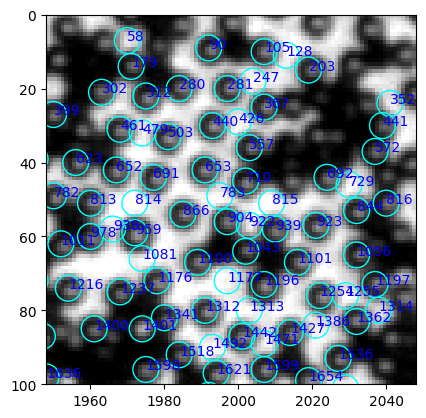
[285]:
table.query("label in [729, 692]")
[285]:
| label | centroid-0 | centroid-1 | intensity_mean | image_intensity | |
|---|---|---|---|---|---|
| 691 | 692 | 44.0 | 2024.0 | 75.88 | [[17, 33, 42, 40, 48], [39, 74, 99, 86, 78], [... |
| 728 | 729 | 46.0 | 2030.0 | 224.64 | [[155, 206, 234, 234, 217], [171, 228, 239, 23... |
The mean intensity is very different between a false positive and a particle. We should also check the center of the image, where the light is brighter.
[286]:
w_circ = [plt.Circle((xi, yi), radius=3.5, linewidth=1, fill=False, ec="cyan") for xi, yi in zip(white.x, white.y)]
w = PatchCollection(w_circ, match_original=True)
fig, ax = plt.subplots(dpi=100)
left, right, bottom, top = 1000, 1100, 300, 200
ax.imshow(img[top:bottom, left:right], cmap="gray", extent=(left, right, bottom, top))
ax.add_collection(w)
for num, i in table.iterrows():
ax.annotate(int(i.label), (i["centroid-1"], i["centroid-0"]), xycoords="data", color="blue")
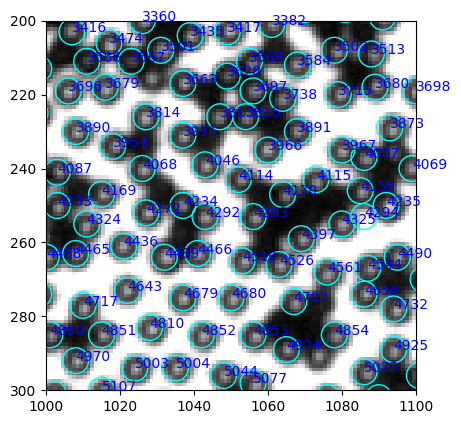
The center has less problems of false positive. Let’s compare 4325 and 4294.
[287]:
table.query("label in [4325, 4294]")
[287]:
| label | centroid-0 | centroid-1 | intensity_mean | image_intensity | |
|---|---|---|---|---|---|
| 4293 | 4294 | 253.0 | 1086.0 | 218.52 | [[179, 187, 194, 177, 128], [196, 225, 238, 22... |
| 4324 | 4325 | 255.0 | 1080.0 | 110.60 | [[70, 87, 102, 92, 106], [84, 130, 162, 122, 1... |
The false positive is still way brighter!
The overall histogram of mean intensity is plotted below.
[288]:
table.hist("intensity_mean")
[288]:
array([[<AxesSubplot: title={'center': 'intensity_mean'}>]], dtype=object)
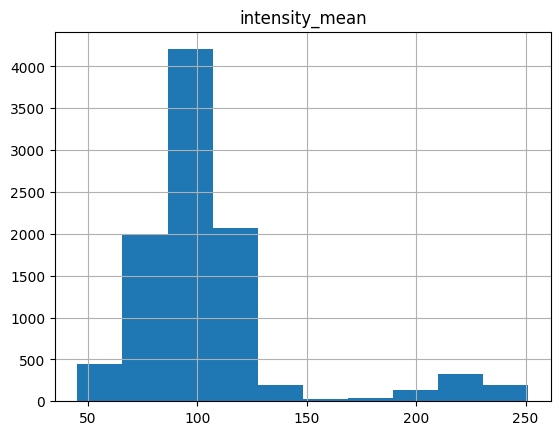
Two peaks already, easy… The threshold is around 170, consistent with previous observation.
[289]:
white_valid = table.query("intensity_mean < 170")
[296]:
w_circ = [plt.Circle((xi, yi), radius=3.5, linewidth=1, fill=False, ec="cyan") for xi, yi in zip(white.x, white.y)]
w = PatchCollection(w_circ, match_original=True)
fig, ax = plt.subplots(ncols=2, dpi=200)
left, right, bottom, top = 1948, 2048, 100, 0
ax[0].imshow(img[top:bottom, left:right], cmap="gray", extent=(left, right, bottom, top))
ax[0].add_collection(w)
for num, i in table.iterrows():
ax[0].annotate(int(i.label), (i["centroid-1"], i["centroid-0"]), xycoords="data", color="blue", fontsize=8)
w_circ = [plt.Circle((xi, yi), radius=3.5, linewidth=1, fill=False, ec="cyan") for xi, yi in zip(white_valid["centroid-1"], white_valid["centroid-0"])]
w = PatchCollection(w_circ, match_original=True)
ax[1].imshow(img[top:bottom, left:right], cmap="gray", extent=(left, right, bottom, top))
ax[1].add_collection(w)
for num, i in white_valid.iterrows():
ax[1].annotate(int(i.label), (i["centroid-1"], i["centroid-0"]), xycoords="data", color="blue", fontsize=8)
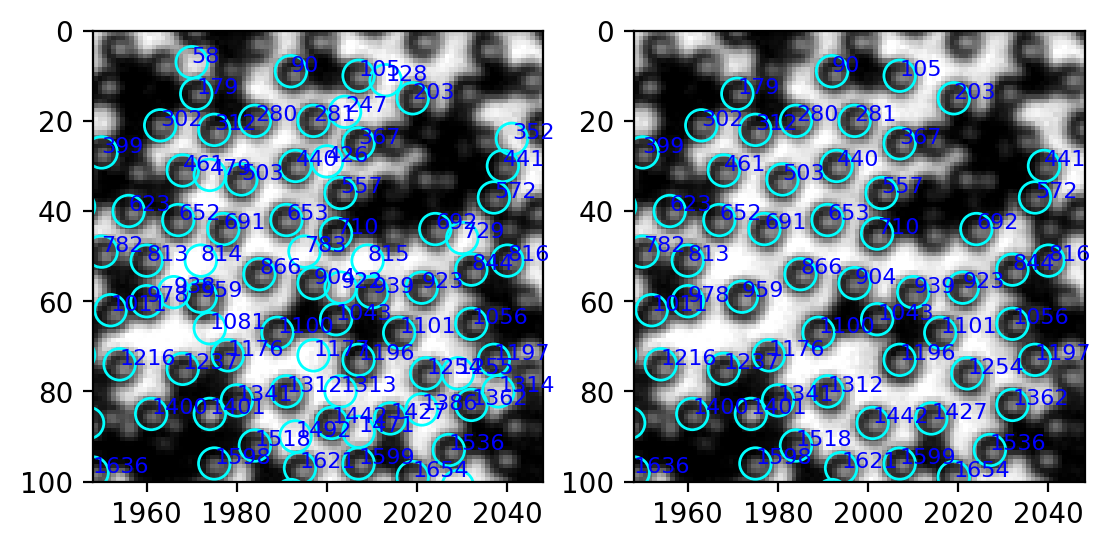
2 Improve efficiency#
The code runs unexpectly slow. On my computer, each frame takes 3 minutes, only to give an unsatisfactory result. Let’s try to improve the speed.
2.1 Which step is slow?#
It turns out that the slowest step is the loop for computing intensity sum. In this example, it takes 1m16s. This can be easily improved by the regionprops method we already used in the previous section.
We modify the function to receive two threshold values for both mean intensity and standard deviation. The function also plots histograms for mean intensity and standard deviation to help us determine good threshold values.
[406]:
def find_black(img, size=7, thres=None, std_thres=None, plot_hist=False):
"""
Find black particles in 乔哥's image.
:param img: raw image to find particles in
:type img: 2d array
:param size: diameter of particle (px)
:type size: int
:param thres: threshold of mean intensity for discerning black and white particles. If None, the function will plot a histogram of mean intensity to help us.
:type thres: int
:param std_thres: threshold of standard deviation for discerning black and white particles. If None, the function will plot a histogram of standard deviation to help us.
.. note::
If ``thres=None`` or ``std_thres=None``, all detected features will be returned. Histograms of mean intensity and standard deviation will be plotted to help us set the threshold.
:return: list of particle positions, pixel value sums and corr map peak values (x, y, pv, peak)
:rtype: pandas.DataFrame
.. rubric:: Edit
* Nov 16, 2022: Initial commit.
* Dec 09, 2022: Speed up by replacing the sum loop with ``regionprops``. Plot histograms to help setting threshold. Include distance check.
"""
img = to8bit(img) # convert to 8-bit and saturate
inv_img = 255 - img
# generate gaussian template according to particle size
gauss_shape = (size, size)
gauss_sigma = size / 2.
gauss_mask = matlab_style_gauss2D(shape=gauss_shape,sigma=gauss_sigma) # 这里的shape是particle的直径,单位px
timg = convolve2d(inv_img, gauss_mask, mode="same")
corr = normxcorr2(gauss_mask, timg, "same") # 找匹配mask的位置
peak = FastPeakFind(corr) # 无差别找峰
# apply min_dist criterion
particles = pd.DataFrame({"x": peak[1], "y": peak[0]})
# 加入corr map峰值,为后续去重合服务
particles["peak"] = corr[particles.y, particles.x]
particles = min_dist_criterion(particles, size)
# 计算mask内的像素值的均值和标准差
## Create mask with feature regions as 1
R = size / 2.
mask = np.zeros(img.shape)
for num, i in particles.iterrows():
rr, cc = draw.disk((i.y, i.x), 0.8*R) # 0.8 to avoid overlap
mask[rr, cc] = 1
## generate labeled image and construct regionprops
label_img = measure.label(mask)
regions = measure.regionprops_table(label_img, intensity_image=img, properties=("label", "centroid", "intensity_mean", "image_intensity")) # use raw image for computing properties
table = pd.DataFrame(regions)
table["stdev"] = table["image_intensity"].map(np.std)
if thres is not None and std_thres is not None:
table = table.loc[(table["intensity_mean"] <= thres)&(table["stdev"] <= std_thres)]
elif thres is None and std_thres is None:
print("Threshold value(s) are missing, all detected features are returned.")
elif thres is not None and std_thres is None:
print("Standard deviation threshold is not set, only apply mean intensity threshold")
table = table.loc[table["intensity_mean"] <= thres]
elif thres is None and std_thres is not None:
print("Mean intensity threshold is not set, only apply standard deviation threshold")
table = table.loc[table["stdev"] <= std_thres]
if plot_hist == True:
table.hist(column=["intensity_mean", "stdev"], bins=20)
table = table.rename(columns={"centroid-0": "y", "centroid-1": "x"}).drop(columns=["image_intensity"])
return table
Here is how to use the function.
[411]:
%%time
black = find_black(img, plot_hist=True)
C:\Users\liuzy\Documents\Github\mylib\xcorr_funcs.py:42: RuntimeWarning: divide by zero encountered in divide
out = out / np.sqrt(image * template)
Threshold value(s) are missing, all detected features are returned.
CPU times: total: 6.64 s
Wall time: 6.66 s
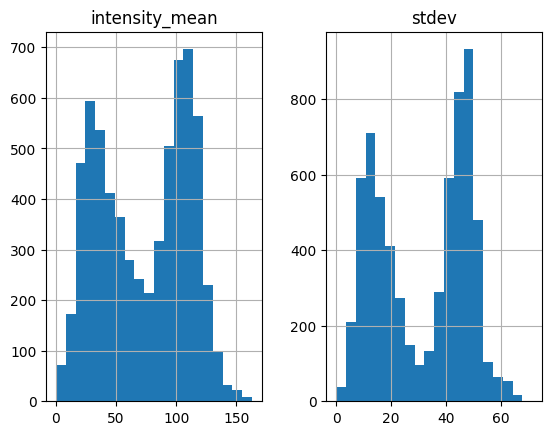
We first notice that the function now is significantly faster than the old version (6.66 s vs. 1m16s). This 8.55 s have already incorporate distance check, which takes about 5 s. It’s possible to optimize distance check, too. I will investigate later.
Keep in mind that white particles have larger standard deviation. The histogram above suggests that we should set std_thres=30.
[412]:
black = find_black(img, size=7, std_thres=30, plot_hist=True)
C:\Users\liuzy\Documents\Github\mylib\xcorr_funcs.py:42: RuntimeWarning: divide by zero encountered in divide
out = out / np.sqrt(image * template)
Mean intensity threshold is not set, only apply standard deviation threshold
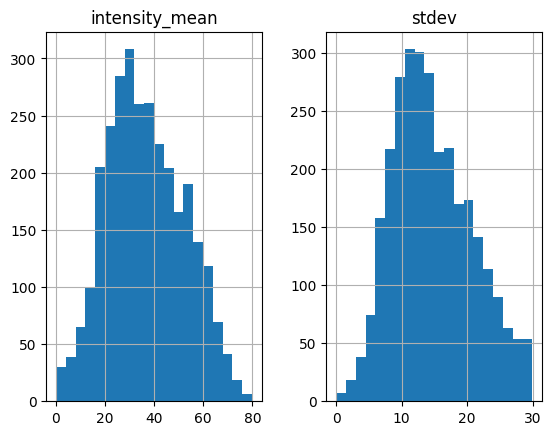
No obvious separation is identified in the new histogram. So let’s check the results. NOTE: although up to now we always find two-peak histograms, it is not necessarily always the case. And even if we don’t see two-peak, it does not mean the criteria fail. In cases where you don’t find double peak, you can play with both threshold and compare results to see if intensity_mean and stdev are still good criteria.
[400]:
b_circ = [plt.Circle((xi, yi), radius=3.5, linewidth=1, fill=False, ec="magenta") for xi, yi in zip(black.x, black.y)]
b = PatchCollection(b_circ, match_original=True)
fig, ax = plt.subplots(dpi=100)
left, right, bottom, top = 1948, 2048, 100, 0
ax.imshow(img[top:bottom, left:right], cmap="gray", extent=(left, right, bottom, top))
ax.add_collection(b)
[400]:
<matplotlib.collections.PatchCollection at 0x247ae9c7ee0>
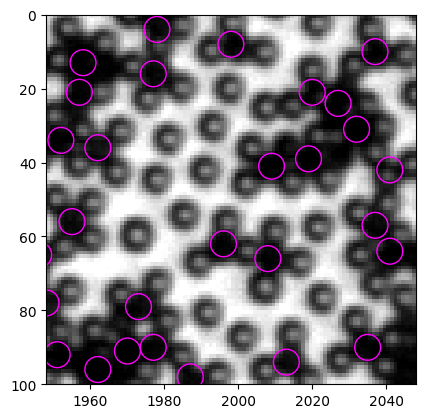
We can compare old method with new method. Since the original old method is too slow because of the for loop, I provide a modified version, which runs much faster but produces same results.
[401]:
def find_black_old(img, size=7, thres=None):
"""
Find black particles in 乔哥's image.
:param img: raw image to find particles in
:type img: 2d array
:param size: diameter of particle (px)
:type size: int
:param thres: threshold for discerning black and white particles. By default, ``thres`` is inferred from the data as mean of the median and the mean of pixel sums of all the particles. However, it is preferred to set a threshold manually, with the knowledge of the specific data.
:type thres: int
:return: list of particle positions, pixel value sums and corr map peak values (x, y, pv, peak)
:rtype: pandas.DataFrame
.. rubric:: Edit
:Nov 16, 2022: Initial commit.
"""
img = to8bit(img) # convert to 8-bit and saturate
inv_img = 255 - img
# generate gaussian template according to particle size
gauss_shape = (size, size)
gauss_sigma = size / 2.
gauss_mask = matlab_style_gauss2D(shape=gauss_shape,sigma=gauss_sigma) # 这里的shape是particle的直径,单位px
timg = convolve2d(inv_img, gauss_mask, mode="same")
corr = normxcorr2(gauss_mask, timg, "same") # 找匹配mask的位置
peak = FastPeakFind(corr) # 无差别找峰
return pd.DataFrame({"x": peak[1], "y": peak[0]})
[408]:
black_old = find_black_old(img)
black_old = min_dist_criterion(black_old, 7)
black_new = find_black(img, std_thres=30)
C:\Users\liuzy\Documents\Github\mylib\xcorr_funcs.py:42: RuntimeWarning: divide by zero encountered in divide
out = out / np.sqrt(image * template)
C:\Users\liuzy\Documents\Github\mylib\xcorr_funcs.py:42: RuntimeWarning: divide by zero encountered in divide
out = out / np.sqrt(image * template)
Mean intensity threshold is not set, only apply standard deviation threshold
[408]:
<matplotlib.collections.PatchCollection at 0x247ac455a90>
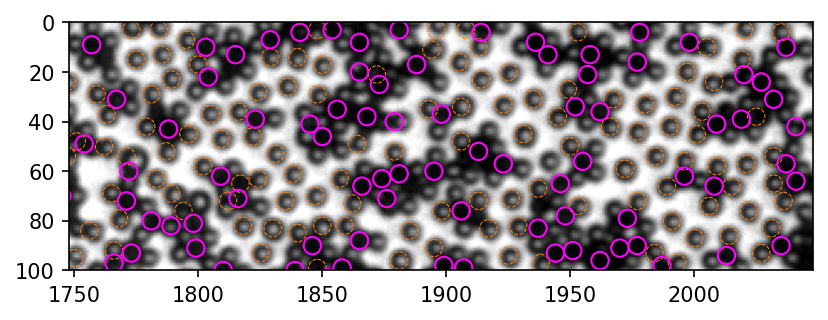
[410]:
fig, ax = plt.subplots(dpi=150)
left, right, bottom, top = 1948, 2048, 100, 0
ax.imshow(img[top:bottom, left:right], cmap="gray", extent=(left, right, bottom, top))
old_circ = [plt.Circle((xi, yi), radius=3.5, linewidth=.5, linestyle="--", fill=False, ec=bestcolor(1)) for xi, yi in zip(black_old.x, black_old.y)]
old = PatchCollection(old_circ, match_original=True)
new_circ = [plt.Circle((xi, yi), radius=3.5, linewidth=1, fill=False, ec="magenta") for xi, yi in zip(black_new.x, black_new.y)]
new = PatchCollection(new_circ, match_original=True)
ax.add_collection(old)
ax.add_collection(new)
[410]:
<matplotlib.collections.PatchCollection at 0x247a857d3a0>
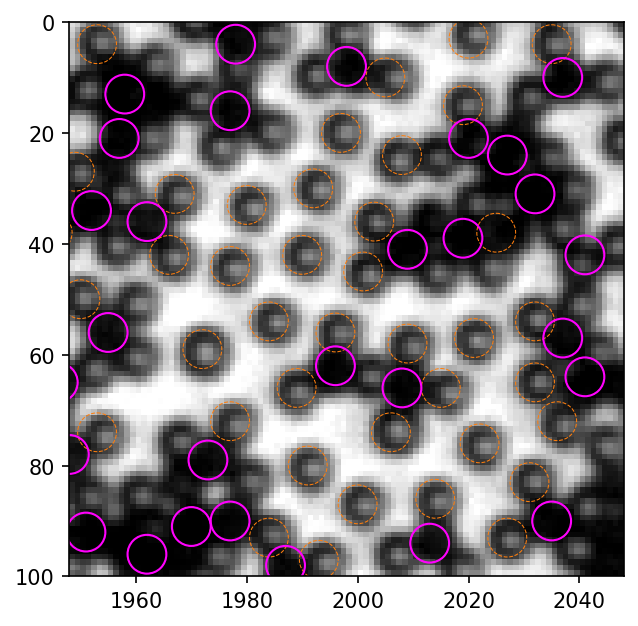
2.2 New find_white#
We can modify find_white in a similar way to speed it up, and to provide histogram for thresholding.
[420]:
def find_white_old(img, size=7, thres=None):
img = to8bit(img) # convert to 8-bit and saturate
mh = mexican_hat(shape=(5,5), sigma=0.8) # 这里shape和上面同理,sigma需要自行尝试一下,1左右
#plt.imshow(mh, cmap="gray")
corr = normxcorr2(mh, img, "same")
coordinates = peak_local_max(corr, min_distance=5)
## Rule out black ones
Y, X = np.mgrid[0:img.shape[0], 0:img.shape[1]]
R = 3.5
pixel_sum_new_list = []
for y, x in coordinates:
mask = (X - x) ** 2 + (Y - y) ** 2 < R ** 2
pv = img[mask].sum()
pixel_sum_new_list.append(pv)
particles = pd.DataFrame({"x": coordinates.T[1], "y": coordinates.T[0], "pv": pixel_sum_new_list})
if thres == None:
thres = (particles.pv.median() + particles.pv.mean()) / 4
return particles.loc[particles.pv >= thres]
[413]:
def find_white(img, size=7, thres=None, std_thres=None, plot_hist=False):
img = to8bit(img) # convert to 8-bit and saturate
mh = mexican_hat(shape=(5,5), sigma=0.8) # 这里shape和上面同理,sigma需要自行尝试一下,1左右
#plt.imshow(mh, cmap="gray")
corr = normxcorr2(mh, img, "same")
coordinates = peak_local_max(corr, min_distance=5)
# apply min_dist criterion
particles = pd.DataFrame({"x": coordinates.T[1], "y": coordinates.T[0]})
# 加入corr map峰值,为后续去重合服务
particles["peak"] = corr[particles.y, particles.x]
particles = min_dist_criterion(particles, size)
# 计算mask内的像素值的均值和标准差
## Create mask with feature regions as 1
R = size / 2.
mask = np.zeros(img.shape)
for num, i in particles.iterrows():
rr, cc = draw.disk((i.y, i.x), 0.8*R) # 0.8 to avoid overlap
mask[rr, cc] = 1
## generate labeled image and construct regionprops
label_img = measure.label(mask)
regions = measure.regionprops_table(label_img, intensity_image=img, properties=("label", "centroid", "intensity_mean", "image_intensity")) # use raw image for computing properties
table = pd.DataFrame(regions)
table["stdev"] = table["image_intensity"].map(np.std)
if thres is not None and std_thres is not None:
table = table.loc[(table["intensity_mean"] <= thres)&(table["stdev"] <= std_thres)]
elif thres is None and std_thres is None:
print("Threshold value(s) are missing, all detected features are returned.")
elif thres is not None and std_thres is None:
print("Standard deviation threshold is not set, only apply mean intensity threshold")
table = table.loc[table["intensity_mean"] <= thres]
elif thres is None and std_thres is not None:
print("Mean intensity threshold is not set, only apply standard deviation threshold")
table = table.loc[table["stdev"] <= std_thres]
if plot_hist == True:
table.hist(column=["intensity_mean", "stdev"], bins=20)
table = table.rename(columns={"centroid-0": "y", "centroid-1": "x"}).drop(columns=["image_intensity"])
return table
[415]:
white = find_white(img, plot_hist=True)
C:\Users\liuzy\Documents\Github\mylib\xcorr_funcs.py:42: RuntimeWarning: divide by zero encountered in divide
out = out / np.sqrt(image * template)
C:\Users\liuzy\Documents\Github\mylib\xcorr_funcs.py:42: RuntimeWarning: invalid value encountered in divide
out = out / np.sqrt(image * template)
Threshold value(s) are missing, all detected features are returned.
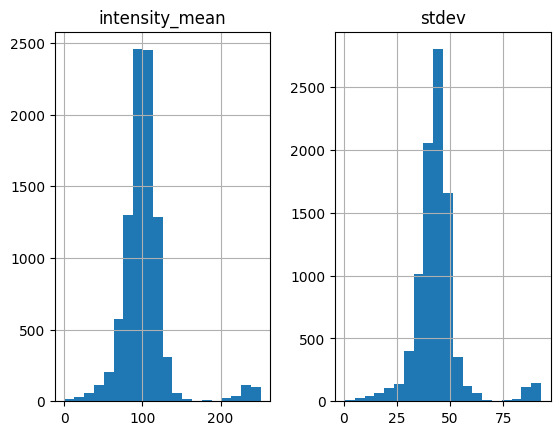
Let’s look at the results to identify problems.
[416]:
w_circ = [plt.Circle((xi, yi), radius=3.5, linewidth=1, fill=False, ec="cyan") for xi, yi in zip(white.x, white.y)]
w = PatchCollection(w_circ, match_original=True)
fig, ax = plt.subplots(dpi=100)
left, right, bottom, top = 1948, 2048, 100, 0
ax.imshow(img[top:bottom, left:right], cmap="gray", extent=(left, right, bottom, top))
ax.add_collection(w)
[416]:
<matplotlib.collections.PatchCollection at 0x2479d132e80>
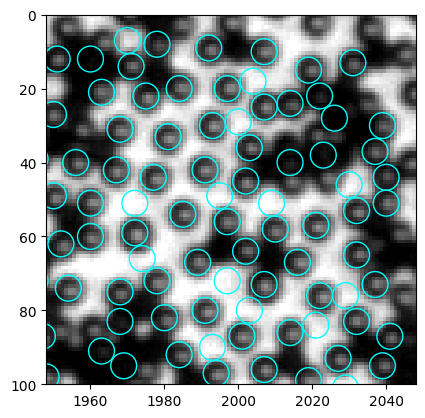
We have discussed before, that mean intensity is a good criterion to discern particle and empty space, in that particles are much darker. And from the intensity histogram, we clearly see a peak at large intensity. Therefore, we set thres=200.
[417]:
white = find_white(img, size=7, thres=200, plot_hist=True)
C:\Users\liuzy\Documents\Github\mylib\xcorr_funcs.py:42: RuntimeWarning: divide by zero encountered in divide
out = out / np.sqrt(image * template)
C:\Users\liuzy\Documents\Github\mylib\xcorr_funcs.py:42: RuntimeWarning: invalid value encountered in divide
out = out / np.sqrt(image * template)
Standard deviation threshold is not set, only apply mean intensity threshold
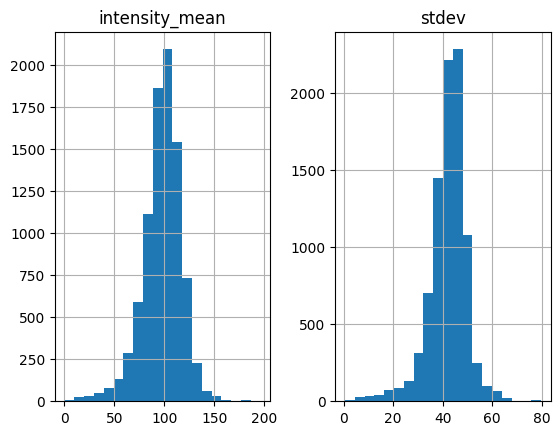
Let’s see if the features in empty space are eliminated.
[418]:
w_circ = [plt.Circle((xi, yi), radius=3.5, linewidth=1, fill=False, ec="cyan") for xi, yi in zip(white.x, white.y)]
w = PatchCollection(w_circ, match_original=True)
fig, ax = plt.subplots(dpi=100)
left, right, bottom, top = 1948, 2048, 100, 0
ax.imshow(img[top:bottom, left:right], cmap="gray", extent=(left, right, bottom, top))
ax.add_collection(w)
[418]:
<matplotlib.collections.PatchCollection at 0x247993b6eb0>
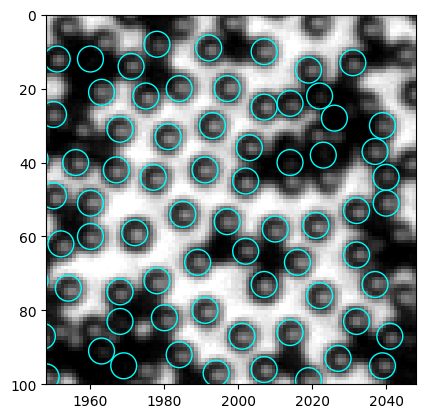
Here we have a problem. The code finds some black particles too, but from the histogram I can hardly think of a good way to filter out the black.
In the old find_white function, we made thres the lower bound of mean intensity. This has effectively eliminated black particles, but is not able to deal with empty space. The way we set default lower bound is somewhat heuristic, but still far from robust:
if thres == None:
thres = (particles.pv.median() + particles.pv.mean()) / 4
For now, let’s keep this lower bound in the code. But keep in mind, if any problem occurs, it’s likely due to this lower bound. It need to be optimized.
[422]:
def find_white(img, size=7, thres=None, std_thres=None, plot_hist=False):
img = to8bit(img) # convert to 8-bit and saturate
mh = mexican_hat(shape=(5,5), sigma=0.8) # 这里shape和上面同理,sigma需要自行尝试一下,1左右
#plt.imshow(mh, cmap="gray")
corr = normxcorr2(mh, img, "same")
coordinates = peak_local_max(corr, min_distance=5)
# apply min_dist criterion
particles = pd.DataFrame({"x": coordinates.T[1], "y": coordinates.T[0]})
# 加入corr map峰值,为后续去重合服务
particles["peak"] = corr[particles.y, particles.x]
particles = min_dist_criterion(particles, size)
# 计算mask内的像素值的均值和标准差
## Create mask with feature regions as 1
R = size / 2.
mask = np.zeros(img.shape)
for num, i in particles.iterrows():
rr, cc = draw.disk((i.y, i.x), 0.8*R) # 0.8 to avoid overlap
mask[rr, cc] = 1
## generate labeled image and construct regionprops
label_img = measure.label(mask)
regions = measure.regionprops_table(label_img, intensity_image=img, properties=("label", "centroid", "intensity_mean", "image_intensity")) # use raw image for computing properties
table = pd.DataFrame(regions)
table["stdev"] = table["image_intensity"].map(np.std)
## Arbitrary lower bound here, be careful!
intensity_lb = (table["intensity_mean"].median() + table["intensity_mean"].mean()) / 4
table = table.loc[table["intensity_mean"]>=intensity_lb]
if thres is not None and std_thres is not None:
table = table.loc[(table["intensity_mean"] <= thres)&(table["stdev"] <= std_thres)]
elif thres is None and std_thres is None:
print("Threshold value(s) are missing, all detected features are returned.")
elif thres is not None and std_thres is None:
print("Standard deviation threshold is not set, only apply mean intensity threshold")
table = table.loc[table["intensity_mean"] <= thres]
elif thres is None and std_thres is not None:
print("Mean intensity threshold is not set, only apply standard deviation threshold")
table = table.loc[table["stdev"] <= std_thres]
if plot_hist == True:
table.hist(column=["intensity_mean", "stdev"], bins=20)
table = table.rename(columns={"centroid-0": "y", "centroid-1": "x"}).drop(columns=["image_intensity"])
return table
[425]:
white = find_white(img, size=7, thres=170, plot_hist=True)
C:\Users\liuzy\Documents\Github\mylib\xcorr_funcs.py:42: RuntimeWarning: divide by zero encountered in divide
out = out / np.sqrt(image * template)
C:\Users\liuzy\Documents\Github\mylib\xcorr_funcs.py:42: RuntimeWarning: invalid value encountered in divide
out = out / np.sqrt(image * template)
Standard deviation threshold is not set, only apply mean intensity threshold
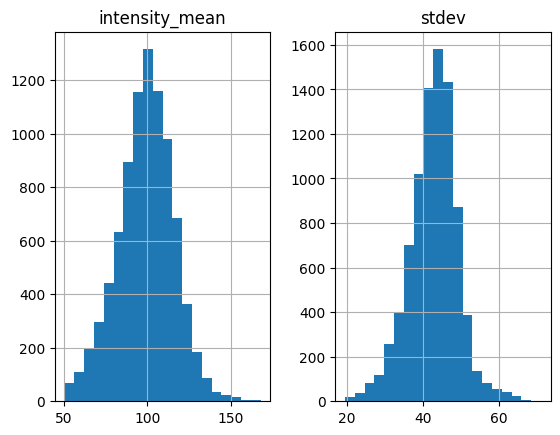
[426]:
w_circ = [plt.Circle((xi, yi), radius=3.5, linewidth=1, fill=False, ec="cyan") for xi, yi in zip(white.x, white.y)]
w = PatchCollection(w_circ, match_original=True)
fig, ax = plt.subplots(dpi=100)
left, right, bottom, top = 1948, 2048, 100, 0
ax.imshow(img[top:bottom, left:right], cmap="gray", extent=(left, right, bottom, top))
ax.add_collection(w)
[426]:
<matplotlib.collections.PatchCollection at 0x247ba16c130>
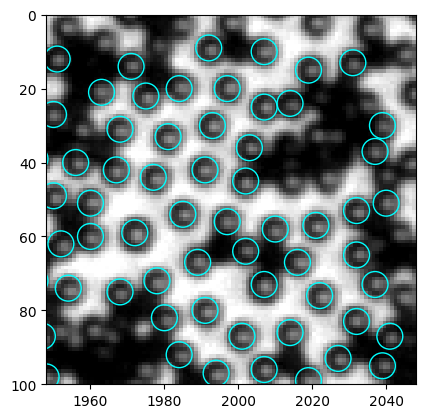
The result looks good to me. So I go ahead to update the functions in the .py file.
3 Last remark#
After this round of edit, the two functions find_black and find_white are largely repetitive, except the mask used. There should be a way to merge the two functions together and make the code more concise.
4 Minimal example#
[5]:
img = io.imread("https://github.com/ZLoverty/bwtrack/raw/main/test_images/large.tif")
[4]:
black = find_black(img, plot_hist=True)
C:\Users\liuzy\Documents\Github\mylib\xcorr_funcs.py:42: RuntimeWarning: divide by zero encountered in true_divide
out = out / np.sqrt(image * template)
Threshold value(s) are missing, all detected features are returned.
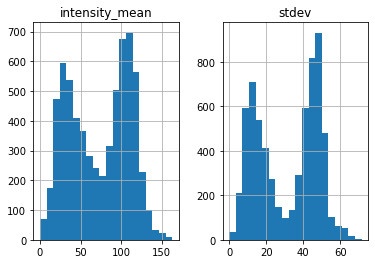
[8]:
black = find_black(img, std_thres=30)
C:\Users\liuzy\Documents\Github\mylib\xcorr_funcs.py:42: RuntimeWarning: divide by zero encountered in true_divide
out = out / np.sqrt(image * template)
Mean intensity threshold is not set, only apply standard deviation threshold
[6]:
white = find_white(img, plot_hist=True)
C:\Users\liuzy\Documents\Github\mylib\xcorr_funcs.py:42: RuntimeWarning: divide by zero encountered in true_divide
out = out / np.sqrt(image * template)
C:\Users\liuzy\Documents\Github\mylib\xcorr_funcs.py:42: RuntimeWarning: invalid value encountered in true_divide
out = out / np.sqrt(image * template)
Threshold value(s) are missing, all detected features are returned.
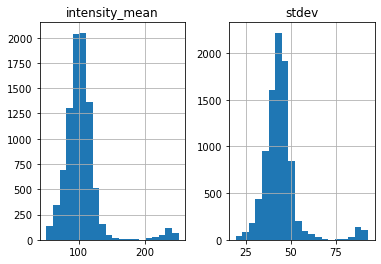
[7]:
white = find_white(img, thres=170)
C:\Users\liuzy\Documents\Github\mylib\xcorr_funcs.py:42: RuntimeWarning: divide by zero encountered in true_divide
out = out / np.sqrt(image * template)
C:\Users\liuzy\Documents\Github\mylib\xcorr_funcs.py:42: RuntimeWarning: invalid value encountered in true_divide
out = out / np.sqrt(image * template)
Standard deviation threshold is not set, only apply mean intensity threshold
[9]:
# corner region
b_circ = [plt.Circle((xi, yi), radius=3.5, linewidth=1, fill=False, ec="magenta") for xi, yi in zip(black.x, black.y)]
b = PatchCollection(b_circ, match_original=True)
w_circ = [plt.Circle((xi, yi), radius=3.5, linewidth=1, fill=False, ec="cyan") for xi, yi in zip(white.x, white.y)]
w = PatchCollection(w_circ, match_original=True)
fig, ax = plt.subplots(dpi=100)
left, right, bottom, top = 1948, 2048, 100, 0
ax.imshow(img[top:bottom, left:right], cmap="gray", extent=(left, right, bottom, top))
ax.add_collection(b)
ax.add_collection(w)
[9]:
<matplotlib.collections.PatchCollection at 0x1f3cc7bb460>
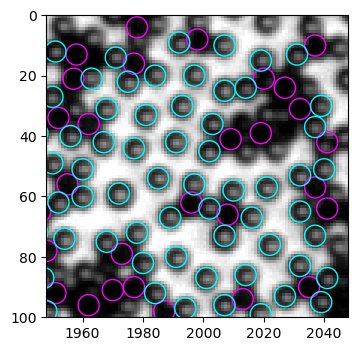
[10]:
# center region
b_circ = [plt.Circle((xi, yi), radius=3.5, linewidth=1, fill=False, ec="magenta") for xi, yi in zip(black.x, black.y)]
b = PatchCollection(b_circ, match_original=True)
w_circ = [plt.Circle((xi, yi), radius=3.5, linewidth=1, fill=False, ec="cyan") for xi, yi in zip(white.x, white.y)]
w = PatchCollection(w_circ, match_original=True)
fig, ax = plt.subplots(dpi=100)
left, right, bottom, top = 950, 1050, 300, 200
ax.imshow(img[top:bottom, left:right], cmap="gray", extent=(left, right, bottom, top))
ax.add_collection(b)
ax.add_collection(w)
[10]:
<matplotlib.collections.PatchCollection at 0x1f3cd61e130>
